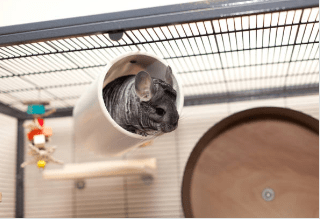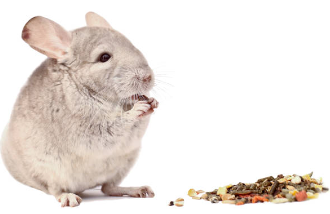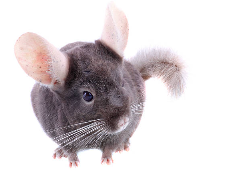Dive into the world of violet chinchillas, where fuzzy meets fabulous!
Ever stumbled upon a chinchilla and thought, “Is that really violet?” As an expert on these curious creatures, I assure you it’s not a figment of your imagination.
Chinchilla violet hues are rare, fascinating, and absolutely delightful.
So, stick around to unravel the mystique behind the purple chinchilla’s allure.
Table of Contents
Describing Violet Chinchillas
Stepping into the vibrant world of chinchillas, one can’t help but be enchanted by the violet variety. These aren’t your everyday shades; they’re a rare symphony of colors that stand out in the chinchilla spectrum.
Characteristics and Appearance of Violet Chinchillas
Distinguished by their plush and dense fur, violet chinchillas shimmer in shades ranging from soft lavender to a deep, mesmerizing purple. Their unique coloration, combined with their round, inquisitive eyes and bushy tails, makes them an exquisite sight, capturing the hearts of many.
Genetics and Inheritance of the Violet Coat Color
The violet hue in chinchillas is the result of specific genetic interactions. Inherited through recessive genes, breeding two carriers increases the chances of producing offspring with this enviable shade. The science behind their hue is as captivating as the chinchillas themselves!
Popularity and Rarity of Violet Chinchillas
The mystique of the violet chinchilla has always garnered attention in the pet world. These distinctive fluffballs aren’t just a beauty to behold but also represent rarity and allure.
- Unique Appeal: The vibrant violet hue of these chinchillas instantly stands out, making them a popular choice among enthusiasts and collectors.
- Rarity: True violet chinchillas are not as commonly found as other color variations. This rarity adds to their demand and intrigue.
- Status Symbol: Owing to their scarcity and charm, owning a violet chinchilla is often seen as a mark of prestige among chinchilla aficionados.
- Increased Demand: As more people learn about the mesmerizing shade of the violet chinchilla, their popularity continues to rise, often leading to waiting lists among breeders.
Caring for Violet Chinchillas
While the alluring hue of violet chinchillas might seem enchanting, it’s imperative to note that their care needs aren’t vastly different from their non-violet counterparts. Like any chinchilla, the key to a healthy and happy life lies in the habitat, diet, health, and grooming practices you provide.
Creating a Suitable Habitat for Violet Chinchillas
Ensuring your chinchilla has a comfortable and safe environment is crucial. The foundation of this is the cage setup and the smaller elements within it.
Cage Setup And Environmental Considerations
A spacious, multi-level cage is a must. Chinchillas are active climbers and enjoy vertical space. Wire cages provide good ventilation, but make sure the spacing between the bars is narrow to prevent escapes.
Position the cage away from direct sunlight, and ensure the room’s temperature remains between 60-70°F. Too much heat can lead to heat stroke since chinchillas lack the ability to sweat.

Providing Hiding Spots and Enrichment Items
Chinchillas, by nature, are prey animals and, as such, seek out hiding spots. Wooden hideaways or hammocks offer them a sense of security. Enrichment is equally important. Chinchilla-safe toys, like wooden chews, pumice stones, and hay balls, keep them mentally stimulated and physically active.
Providing Proper Nutrition and Diet
Violet or not, a chinchilla’s diet is primarily hay-based. Timothy Hay should be available at all times. Pelleted chinchilla food can supplement their diet, but avoid mixes with seeds or nuts. Fresh water is a must, and occasional treats like dried herbs or a raisin can be given sparingly.

Health Considerations for Violet Chinchillas
Regularly observe your chinchilla for any signs of discomfort or illness. Early detection of issues like dental problems, respiratory infections, or digestive issues can make a significant difference. Familiarize yourself with local veterinarians specializing in small mammals or exotics.
Grooming and Hygiene Practices
The stunning coat of the violet chinchilla requires consistent care to maintain its luster and health.
Coat Care And Brushing Techniques
Chinchillas naturally keep their fur clean through dust baths. Offering a chinchilla dust bath 2-3 times a week helps remove oils and dirt. Between baths, a gentle brush can help keep the fur smooth, preventing any potential matting.
Nail Trimming And Dental Health
Nails should be checked regularly and trimmed as needed. Overgrown nails can hinder movement and cause discomfort. Dental health is vital, as chinchillas’ teeth grow continuously. Offering wood chews can help naturally wear down their teeth, preventing overgrowth.
Breeding and Genetics of Violet Chinchillas
Diving into the domain of chinchilla breeding, especially the alluring violet variety, one enters a world where genetics, careful selection, and responsible practices intertwine.
The stunning violet hue doesn’t occur merely by chance—it’s a result of specific genetic codes and dedicated breeding techniques.
Understanding the Genetics of Violet Coat Color
The captivating violet coat color of chinchillas can be attributed to particular genetic configurations. Unlike dominant colors, the violet shade emerges from recessive genes.
When two carriers of this gene are mated, the likelihood of obtaining a violet offspring increases. However, it’s more complex than mere math; understanding genetic markers and patterns is paramount.
Selective Breeding for Violet Chinchillas
Achieving the desired violet hue isn’t as simple as pairing any two violet chinchillas. Selective breeding is a meticulous process where breeders choose chinchillas with the best genetic attributes to enhance the quality and purity of the violet color in offspring.
This can mean looking at lineage, past litters, and even assessing fur quality and vibrancy.
Responsible Breeding Practices
In the pursuit of the perfect violet shade, ethics shouldn’t be overlooked.
Breeding considerations and ethical guidelines
Overbreeding or inbreeding can lead to a host of health issues for chinchillas. It’s essential to prioritize the well-being of the animals over color perfection. This includes allowing adequate resting periods between litters and ensuring genetic diversity to prevent congenital health problems.
Working with reputable breeders
When seeking violet chinchillas, aligning with ethical, reputable breeders is crucial. They prioritize chinchilla health, ensure ethical breeding practices, and offer transparency about lineage and breeding history.
Such breeders provide invaluable insights and can be sources of continued guidance for both novice and seasoned chinchilla enthusiasts.
Socializing and Bonding with Violet Chinchillas
Ah, the joys of forging a bond with a violet chinchilla! Their vibrant hue may be a visual treat, but it’s their personality that truly enchants. Establishing trust, fostering interaction, and stimulating their minds are essential elements in this journey.
Building Trust and Establishing a Bond
Chinchillas are innately cautious creatures. Gradual introductions, gentle voice tones, and consistent interactions lay the groundwork for trust. Offering treats from your hand or sitting near their cage lets them associate you with positive experiences, strengthening the bond over time.
Handling and Interacting with Violet Chinchillas
When handling chinchillas, ensure your movements are calm and deliberate. Scooping them up rather than grabbing them ensures they feel safe. Daily interactions, whether it’s playtime outside the cage or just talking to them, help maintain this bond.
Enrichment Activities and Mental Stimulation
Chinchillas are intelligent and curious. Toys like wooden chews, tunnels, and wheels not only entertain but also challenge their minds. Rotate toys and introduce new environments occasionally to keep their surroundings engaging.
Showing and Exhibiting Violet Chinchillas
Stepping into the spotlight with a violet chinchilla is an exhilarating experience. But beyond their stunning hue, understanding the nuances of chinchilla shows ensures they shine bright in all their glory.
The Role of Coat Color in Chinchilla Shows
In chinchilla exhibitions, coat color plays a significant role. While conformation, size, and fur quality are fundamental, the vibrancy, clarity, and consistency of the violet shade can set a chinchilla apart. Judges often seek a deep, even color, free from patches or inconsistencies.
Preparing Violet Chinchillas for Show Competitions
Preparation is key. Regular grooming ensures their fur is at its best. It’s also vital to familiarize them with the show environment, reducing potential stress. This includes brief stints in show cages and exposure to increased handling.
Show Etiquette and Presentation Tips
When at the show, always handle your chinchilla gently, showcasing their temperament. Ensure their cage is clean and presentable. Engage with judges and attendees politely, sharing insights about your chinchilla’s lineage and care.
Conclusion
The world of violet chinchillas is as intriguing as it sounds. Dive deeper, and you’ll discover a pet that’s not just about a pretty coat, but also offers companionship, delight, and a touch of luxury to your life.
So, whether you’re a prospective owner or just a curious soul, violet chinchillas promise a world filled with wonder!
FAQs
Are violet chinchillas naturally occurring or a result of breeding?
Violet chinchillas result from specific genetic combinations, often achieved through selective breeding.
Do violet chinchillas require special care compared to other chinchilla colors?
No, their care needs are similar to other chinchillas; only their coat color differs.
How rare are violet chinchillas in the pet market?
Violet chinchillas are rarer than some other color variations, adding to their allure and demand.
Alina Hartley is a small-town girl with a ginormous love of bearded dragons. It all started with Winchester, a baby bearded who was abandoned at the shelter by his former owners because of a birth defect that caused one front leg to be shorter than the other. Alina originally went to the shelter looking for a guinea pig, but one look at Winchester and it was love at first sight. From that day on, Alina has dedicated her life to learning everything she can about bearded dragons. She loves helping new beardie parents start their incredible journey with these magnificent reptiles.
Follow her on:
LINKEDIN
TWITTER.
Read her latest articles HERE
Learn more about her HERE.

